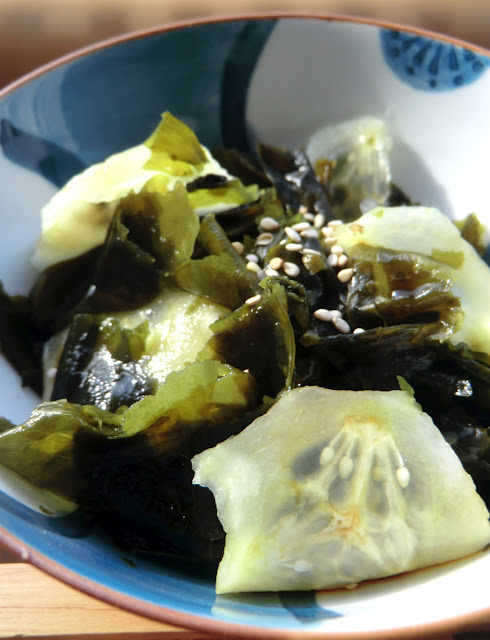En este último mes parece no quedar claro si se acerca el buen tiempo o no, por lo que pasas de tomarte un caldo a una ensalada en cuestión de horas. Es precisamente por esto por lo que os propongo esta ensalada. No es la típica para tomar de plato único, es perfecta como acompañamiento, por lo que podéis acompañarla de algo calentito en los días más frios o otro entrante fresquito en los más calurosos.
INGREDIENTES: (para 2)
- 10g de algas wakame secas
- 1 pepino mediano
- 2 cucharaditas de salsa de soja
- 1/2 cucharadita de azúcar
- 1/2 cucharadita de vinagre de arroz
- 1/2 cucharadita de zumo de limón
- Sésamo tostado (opcional)
Partid las algas con las manos en trozos pequeños (al hidratarse crecen mucho) y ponedlas a hidratar durante 15 minutos.
Mientras tanto pelad el pepino y partidlo en rodajas finas.
Mezclad el azúcar, el vinagre, la salsa de soja y el zumo de limón en un botecito.
Escurrid las algas y ponedlas en un cuenco junto con el pepino y aliñad con el contenido del bote. Dejad que coja el sabor durante un rato antes de comer (unos 10 min).
Decorad con el sésamo.
________________________________________________
This last month the weather doesn't want to let us know if we are heading towards good or bad weather, so you pass from salad to hot soup in a matter of hours.
This is precisely why I propose you this salad. It's not a main course salad, but it's perfect as a side-dish, so you can have it with something hot in cool days or something cool in warmer days.
INGREDIENTS: (serves 2)
- 10g dried wakame seaweed
- 1 medium size cucumber
- 2 teaspoons soy sauce
- 1/2 teaspoon sugar
- 1/2 teaspoon rice vinegar
- 1/2 teaspoon lemon juice
- Roasted sesame (optional)
Cut the wakame with your hands in small pieces (after re-hydration they will become quite large) and re-hydrate them for 15 minutes.
Meanwhile peel the cucumber and slice it.
In a jar mix the sugar, vinager, soy sauce and lemon juice.
Drain the water from the seaweed and place them in a bowl with the cucumber and season with the mix from the jar.
Let it settle for 10 minues or so before eating to let the flavour enter the ingredients.
Decorate with roasted sesame.











